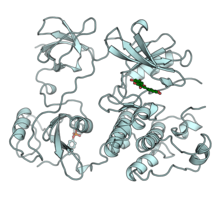
Back كيناز التيروسين Arabic Tirozin-kinaza BS Tirosina-cinasa Catalan Tyrosinkináza Czech Tyrosinkinasen German Tirosina quinasa Spanish Türosiinkinaas Estonian تیروزین کیناز Persian Tyrosine kinase French Tirosina quinase Galician
| Protein tyrosine kinase | |||||||||
|---|---|---|---|---|---|---|---|---|---|
 | |||||||||
| Identifiers | |||||||||
| Symbol | Pkinase_Tyr | ||||||||
| Pfam | PF07714 | ||||||||
| InterPro | IPR001245 | ||||||||
| SMART | TyrKc | ||||||||
| PROSITE | PDOC00629 | ||||||||
| SCOP2 | 1apm / SCOPe / SUPFAM | ||||||||
| OPM superfamily | 186 | ||||||||
| OPM protein | 2k1k | ||||||||
| CDD | cd00192 | ||||||||
| Membranome | 3 | ||||||||
| |||||||||
A tyrosine kinase is an enzyme that can transfer a phosphate group from ATP to the tyrosine residues of specific proteins inside a cell. It functions as an "on" or "off" switch in many cellular functions.
Tyrosine kinases belong to a larger class of enzymes known as protein kinases which also attach phosphates to other amino acids such as serine and threonine. Phosphorylation of proteins by kinases is an important mechanism for communicating signals within a cell (signal transduction) and regulating cellular activity, such as cell division.
Protein kinases can become mutated, stuck in the "on" position, and cause unregulated growth of the cell, which is a necessary step for the development of cancer. Therefore, kinase inhibitors, such as imatinib and osimertinib, are often effective cancer treatments.
Most tyrosine kinases have an associated protein tyrosine phosphatase, which removes the phosphate group.